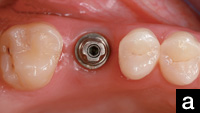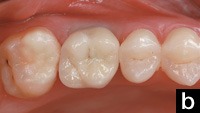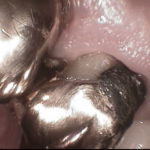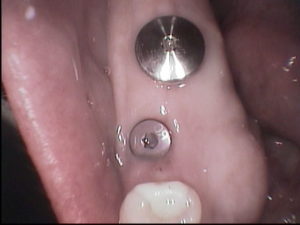What are Dental Implants?
Dental implants are used to replace missing teeth. Over the past thirty years, dental implant systems have been extensively researched and placed. They rank amongst the most successful procedure we have available in dentistry.
As far as how these work, there is a space that used to be occupied by a previous tooth. A dental implant is a man-made artificial root form made of titanium: the same titanium used in the replacement of hip and knee joints.
Basically, implants are wide screws which are hollow in the top half. Inside this hollow space of the implant is a threaded section. In this threaded hollow section we can place an initial healing component. This component is screwed in and is used to allow the gums to heal following implant placement.

After complete healing of the implant and the gums, this healing component is unscrewed and a different component can be placed. This second component is called an abutment. This abutment is used to support a crown or perhaps a denture or partial denture.
The images contained in this article show actual dental implants which have been placed and are healed. These implants are ready to receive the appropriate abutments.

Dental implants allow function and aesthetics which can rival natural teeth. Many patients have been very satisfied to have such a solid option to replace their teeth.
With dental implants, a new tooth can be created that functions very much like a natural tooth. Since the new tooth is supported only by the dental implant, the tooth can also be flossed like a natural tooth. The final result many times can look very natural as well.
Replacing a Non-Restorable Tooth with a Dental Implant
There are times when a tooth simply cannot be saved. This tooth has a failing root canal treatment and it has extensive decay in the root structure. There is too much damage to be repaired.
On occasions like this, the tooth must be extracted. In extracting the tooth, the resulting tooth socket is packed with a grafting material. By using the grafting material, the volume of available jawbone for the subsequent dental implant is maximized.
With a maximized amount of jawbone, the dental implant has a strong foundation of support. It may take up to four months for the jawbone to fill in adequately enough prior to placement of the dental implant.
Following placement of the dental implant, a period of up to four months is needed to assure a solid attachment of the implant to the jawbone. After that, procedures can be done to make the final crown.
It can take up to nine months from the time of extraction to have the entire plan completed.
There are times when this timing can be decreased. However, if decisions are made in certain cases to speed up the process, the predictability of the final result is more unknown and the probability of failure may go up.
Our patients can feel assured that we make every effort to create a final result which is indeed predictable and highly successful.
Single Tooth Dental Implant or a Bridge?
There are times when a patient is missing a single tooth. There are basically two options for replacing the missing tooth.
One option is placing a dental implant. This option allows for a replacement to be provided without the need to modify the adjacent teeth. It also allows for simple hygiene procedures, since the new tooth can be flossed just the same as a natural tooth.
The second option for replacing the missing tooth is to place a bridge. In this option, the adjacent teeth in front of and behind the missing tooth are prepared for a crown. If only one adjacent tooth is present, then an implant would be recommended, since a bridge cannot be made.
A bridge is basically two crowns that are connected by a “solid crown” which replaces the missing tooth. In this option, flossing is more difficult. A floss threader is needed to pull the floss through the bridge near the gumline in order to allow flossing to be achieved.
This option is also very predictable and has been utilized in dentistry for many years. A large downside to a bridge is that in some cases healthy teeth are prepared for crowns that otherwise would not have required treatment.
In deciding which option to pursue, one factor to be considered is the condition of the adjacent teeth. If the teeth are healthy or are not in need of treatment, then an implant may well be the better option.
If at least one of the teeth requires crown coverage for some reason, then a bridge may be the more rational option.
Another factor to consider in deciding between an implant or a bridge is the condition of the bone at the location of the missing tooth. If there is not enough bone to support a dental implant, then perhaps a bridge would be a better option.
Do you have questions about dental implants? Please contact us today to learn more about your options.


